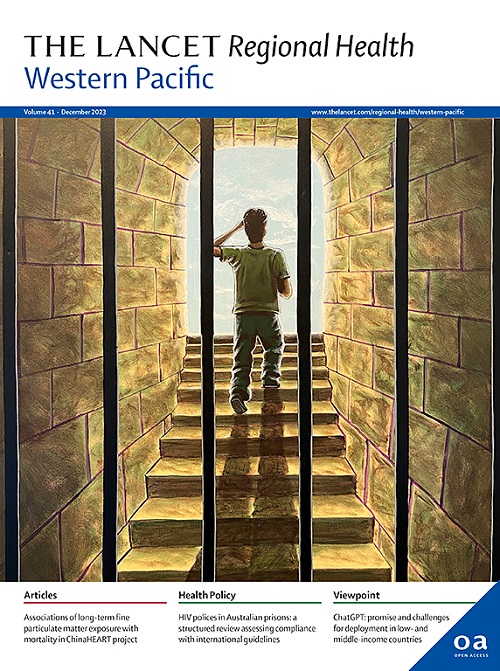Mortality among transgender persons: a Taiwan matched-population and sibling-comparison cohort study
IF 8.1
1区 医学
Q1 HEALTH CARE SCIENCES & SERVICES
引用次数: 0
Abstract
Background
Transgender persons have been reported to experience excess mortality, but evidence is dominated by Western cohorts and seldom addresses familial confounding.
Methods
We conducted a nationwide, retrospective cohort study using two prespecified comparison designs: matched population controls (1:4, matched on legal sex and birth date) and within-family cisgender sibling comparisons. Transgender persons were identified by ≥2 psychiatrist-recorded gender identity disorder diagnoses during 2001–2021; cohort entry required age ≥6 years. Participants were followed until death or December 31, 2022. We compared all-cause, external-cause (suicide and accidents), and internal-cause mortality using Cox regression adjusted for sociodemographics and medical comorbidity.
Findings
Among 3906 transgender persons (mean age 24.6 years; 70.6% with a male legal sex) and 15,624 controls (mean follow-up 9.5 years), psychiatric conditions were markedly over-represented in the transgender cohort (e.g., depressive disorders 40.8% vs 5.7%). Adjusted hazard ratios were 1.40 (95% confidence interval 1.06–1.84) for all-cause mortality, 2.03 (1.39–2.96) for external causes, and 4.07 (2.52–6.59) for suicides; accidents (0.56, 0.21–1.45) and internal-cause (0.98, 0.65–1.48) mortality did not differ. In sibling comparisons (4765 siblings), excess all-cause and external-cause mortality were not observed (0.96, 0.67–1.36; and 1.14, 0.70–1.85), suicide risk was higher (2.57, 1.32–5.00), and accident mortality lower (0.19, 0.06–0.67). Relative hazards were greatest in those with a female legal sex and in adolescents. Adjustment for psychiatric clusters attenuated—but did not eliminate—the suicide mortality excess.
Interpretation
In Taiwan, transgender persons had higher all-cause and suicide mortality than population controls; in within-family comparisons, the suicide mortality excess persisted, indicating influences beyond shared familial factors. Prevention should prioritize targeted mental-health and safety interventions, with particular attention to adolescents and those with a female legal sex.
Funding
Taiwan National Science and Technology Council.
跨性别者死亡率:台湾配对人口与兄弟姊妹比较队列研究
背景:有报道称跨性别者死亡率过高,但证据主要来自西方人群,很少涉及家族混淆。方法我们进行了一项全国性的回顾性队列研究,采用两种预先指定的比较设计:匹配人群对照(1:4,法定性别和出生日期匹配)和家庭内的顺性别兄弟姐妹比较。2001-2021年期间,跨性别者被精神科医生记录的性别认同障碍诊断诊断为≥2例;队列入组要求年龄≥6岁。参与者被跟踪到死亡或2022年12月31日。我们比较了全因、外因(自杀和事故)和内因死亡率,使用Cox回归校正了社会人口统计学和医疗合并症。研究结果:在3906名跨性别者(平均年龄24.6岁,70.6%为合法性别男性)和15624名对照者(平均随访9.5年)中,精神疾病在跨性别队列中的比例明显过高(例如,抑郁症40.8%对5.7%)。调整后的全因死亡率风险比为1.40(95%可信区间1.06-1.84),外因死亡率风险比为2.03(1.39-2.96),自杀死亡率风险比为4.07 (2.52-6.59);意外死亡率(0.56,0.21-1.45)和内因死亡率(0.98,0.65-1.48)无差异。在兄弟姐妹比较(4765名)中,未观察到过多的全因死亡率和外因死亡率(0.96,0.67-1.36;1.14,0.70-1.85),自杀风险较高(2.57,1.32-5.00),事故死亡率较低(0.19,0.06-0.67)。在合法性别的女性和青少年中,相对危险最大。对精神病群体的调整减弱了——但没有消除——自杀死亡率的过剩。在台湾,跨性别者的全因死亡率和自杀死亡率高于人口控制组;在家庭内部比较中,自杀死亡率持续过高,表明影响超出了共同的家庭因素。预防工作应优先考虑有针对性的心理健康和安全干预措施,特别关注青少年和合法性别为女性的人。
本文章由计算机程序翻译,如有差异,请以英文原文为准。
求助全文
约1分钟内获得全文
求助全文
来源期刊

The Lancet Regional Health: Western Pacific
Medicine-Pediatrics, Perinatology and Child Health
CiteScore
8.80
自引率
2.80%
发文量
305
审稿时长
11 weeks
期刊介绍:
The Lancet Regional Health – Western Pacific, a gold open access journal, is an integral part of The Lancet's global initiative advocating for healthcare quality and access worldwide. It aims to advance clinical practice and health policy in the Western Pacific region, contributing to enhanced health outcomes. The journal publishes high-quality original research shedding light on clinical practice and health policy in the region. It also includes reviews, commentaries, and opinion pieces covering diverse regional health topics, such as infectious diseases, non-communicable diseases, child and adolescent health, maternal and reproductive health, aging health, mental health, the health workforce and systems, and health policy.
 求助内容:
求助内容: 应助结果提醒方式:
应助结果提醒方式:


